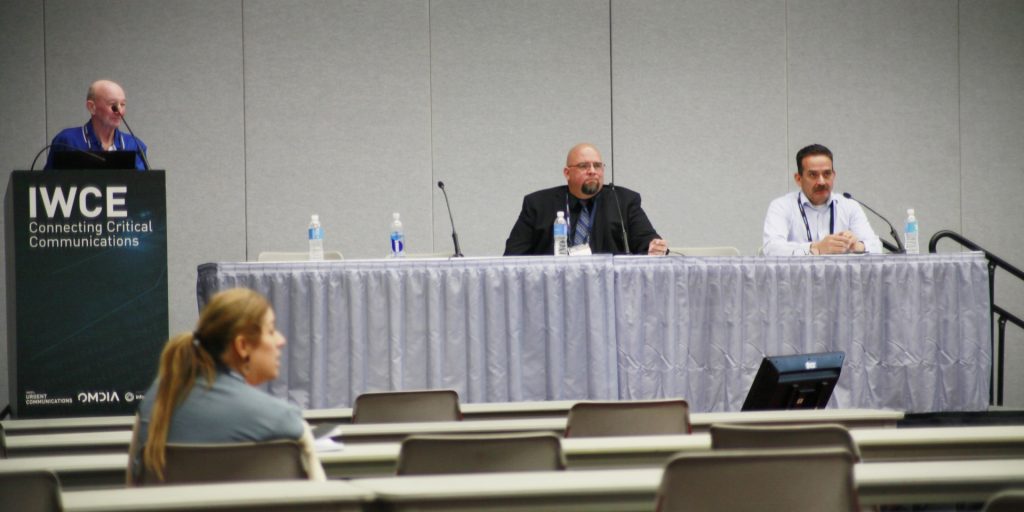
Catalyst is at IWCE this week, and on Tuesday, Catalyst Vice President Jack Kelly moderated a panel on Work From Home Alternatives for Dispatchers – what the pandemic taught us. IWCE show contributor Andy Castillo was present for the action and filed this report.
- Written by Andy Castillo
- 22nd March 2022
The work-from-home evolution sparked by the ongoing COVID-19 pandemic two years ago wasn’t just limited to the commercial sector; many telecommunicators also found themselves suddenly logging in from the couch.
“The pandemic has caused more of a need for remote and backup dispatch operations,” said Jack Kelly, vice president of Catalyst Communications Technologies, a company that facilitates radio over internet protocol communications. He was speaking at a talk titled “Work from home alternatives for dispatchers—What the pandemic taught us” at this year’s 2022 International Wireless Communications Expo (IWCE), held this week in Las Vegas, Nevada. The expo started Monday and will continue through Thursday.
For government organizations looking to expand their emergency communications center’s (ECC) capacity to be able to operate remotely, Kelly stressed an important takeaway: It takes time, patience and a lot of effort.
“What we learned from that is the organizations that had prepared for some sort of alternative dispatch facility were in really good shape when the pandemic showed up, and those that were not were scrambling to put something into place,” he continued.
Speaking on a panel with Kelly alongside Matthew Boggs, a representative of Cradlepoint, a tech company that produces secure cloud-based networking equipment, Eddie Reyes of the Virginia-based Prince William County Department of Public Safety Communications reflected the same sentiment. Reyes expanded his organization’s remote capability during the pandemic.
“If you don’t have this capability built into your toolbox yet, you should start planning,” Reyes said, noting “It doesn’t happen overnight. … You have to be operable before you can become interoperable.”
Speaking from his experience helping ECCs create secure connections from remote locations, Boggs said he’s tweaked a motto as a guide: “Semper gummy, always flexible. Nothing will be static,” he noted. “You need to be able to secure it, you need to be agile and functional, you need to be able to do more with less, and you need to be able to do it on the fly, because lives are in jeopardy.”
That’s a big ask, but it’s not impossible, according to Reyes. Tech innovations including Cradlepoint, which can segment a network to create secure pathways for telecommunicators to operate within, have made commonplace today what wasn’t thought possible a decade ago.
In more than three decades of public service, both as a police officer and a telecommunicator, Reyes said he’s seen “more innovation in the last three years than I saw in my first 30 years.”
Modern portable solutions “pretty much duplicate” the capabilities a dispatcher has at a hardened public safety answering point (PSAP).
“Most of the problems that were associated with what I call ‘version one’ … have pretty much gone away,” Kelly said. By way of example, he described a mobile dispatch system his company designed for the organizers of Burning Man, an annual and well-attended art event held in the Nevada desert.
Burning Man is held on public land owned by the U.S. Bureau of Land Management, and because of that, permanent infrastructure can’t be erected. Instead, “We built a portable trailer for them, and they drive it out to the desert and set up a portable dispatch system,” Reyes said.
While portable dispatch units had been gradually becoming more popular over the last decade—to fill the gap during ECC renovations, for example, or during large-scale events—the pandemic served as a catalyst for organizations across the United States to create remote opportunities for employees.
In this effort, Reyes said a primary reason decision makers cite as a reason not to implement a remote system is cybersecurity. But a cyber-attack is by far “a less likely occurrence than not having enough employees.
“The human challenge is far more difficult—the ECC can’t operate at all without someone manning the phone,” Reyes said. “Right now, as I’m speaking to you, I have 10 vacancies in my center.” The human challenge “keeps me awake at night” far more often than any technical risks.
That being said, it’s not an easy path to remote capability. Inevitably, any effort to implement a remote telecommunication system will be met with failures and encounter speedbumps along the way. Further, remote dispatch, which operates via the cloud, isn’t as capable or clear as it is in-person. If a radio system is outdated or functioning poorly to begin with, it will only perform worse within a hybrid or remote work situation.
“Whatever equipment you have, it’ll deteriorate in quality. So, if you have a bad system to start, it’s not going to be sufficient,” he continued.
Add to that the complexity of the types of scenarios that might require telecommunicators to work remotely—for example, a wildfire baring down on an ECC. It’s best to prepare for the worst.
“Anything that can happen usually does happen in those types of deployments. You wouldn’t go on a road trip without a good spare tire that has plenty of air,” Reyes said. “It can be very complex, and I would say it’s not friendly to do it. But also, it’s not impossible.”

